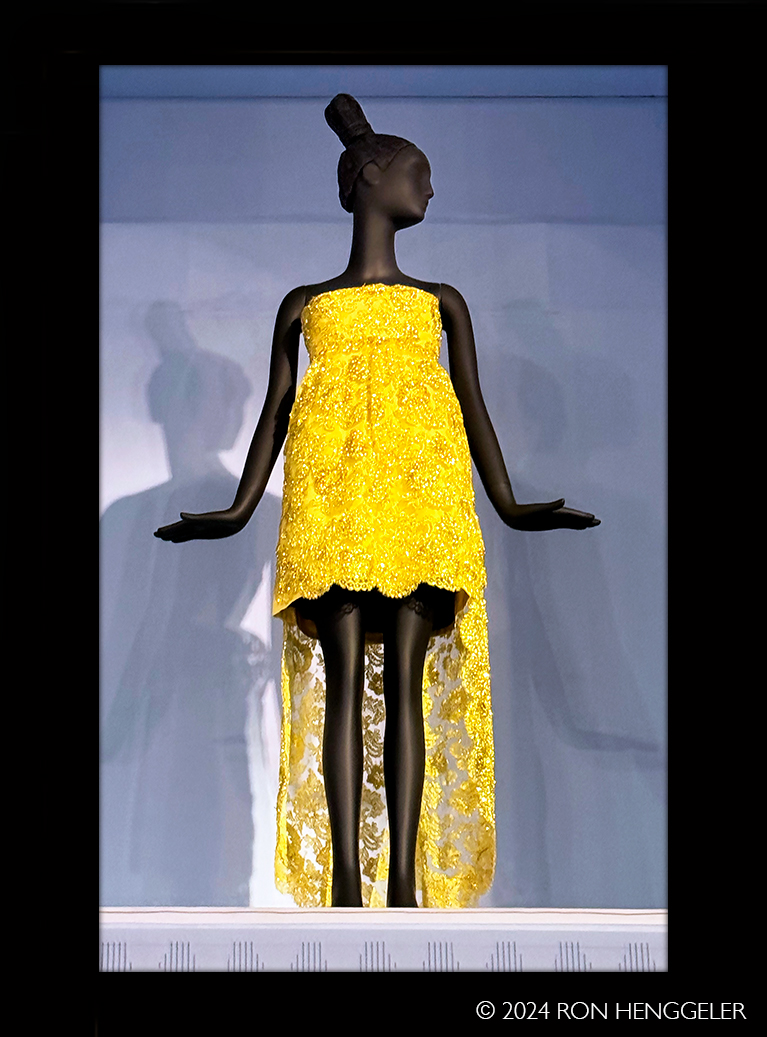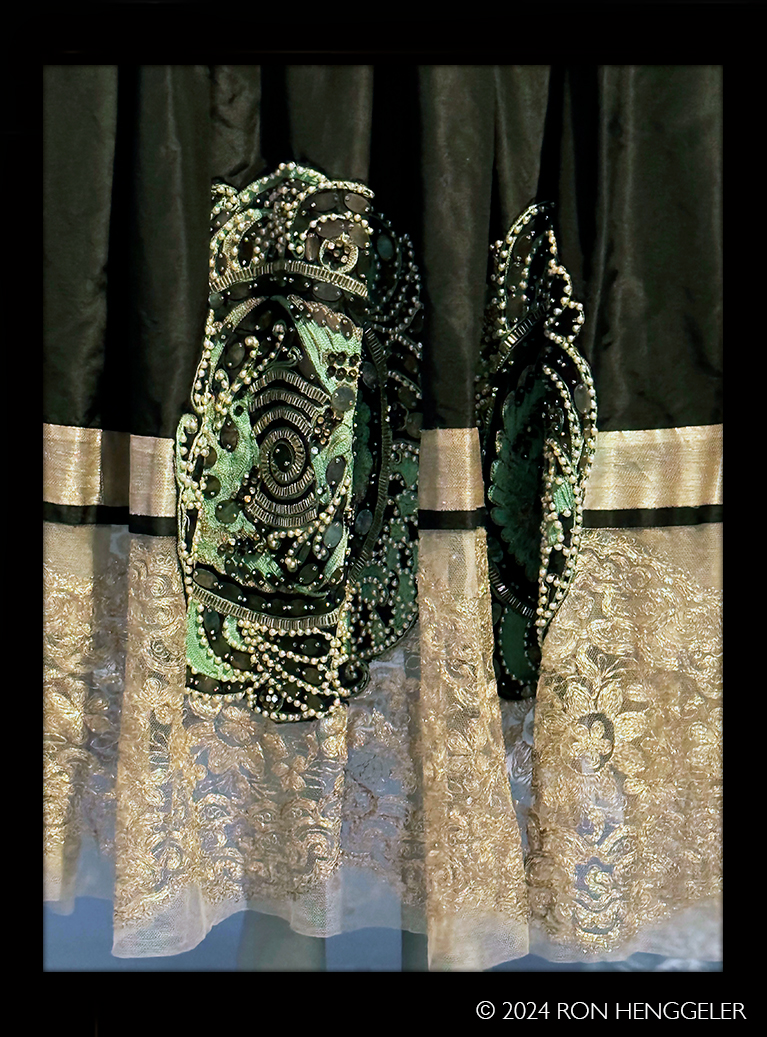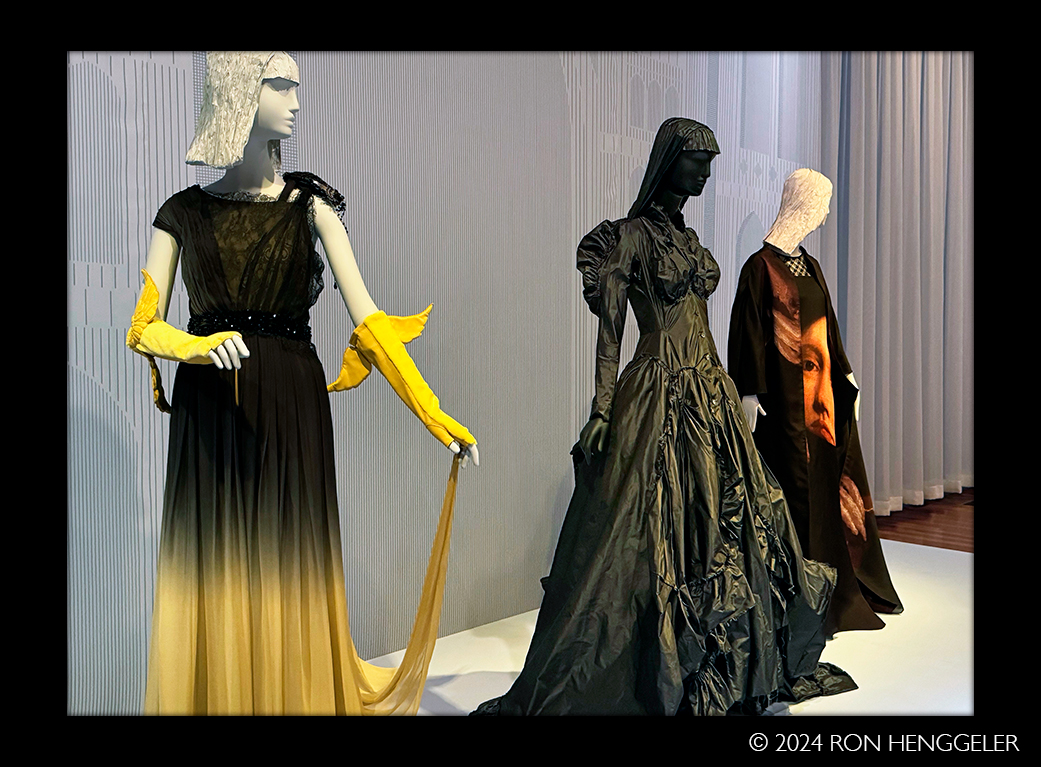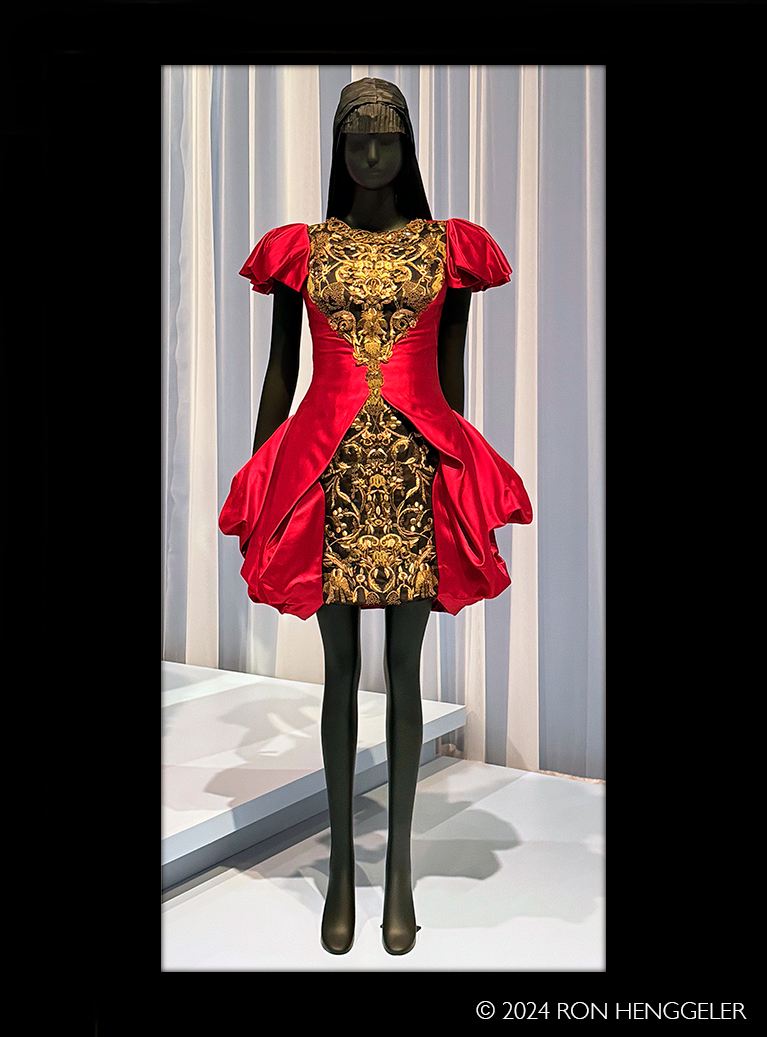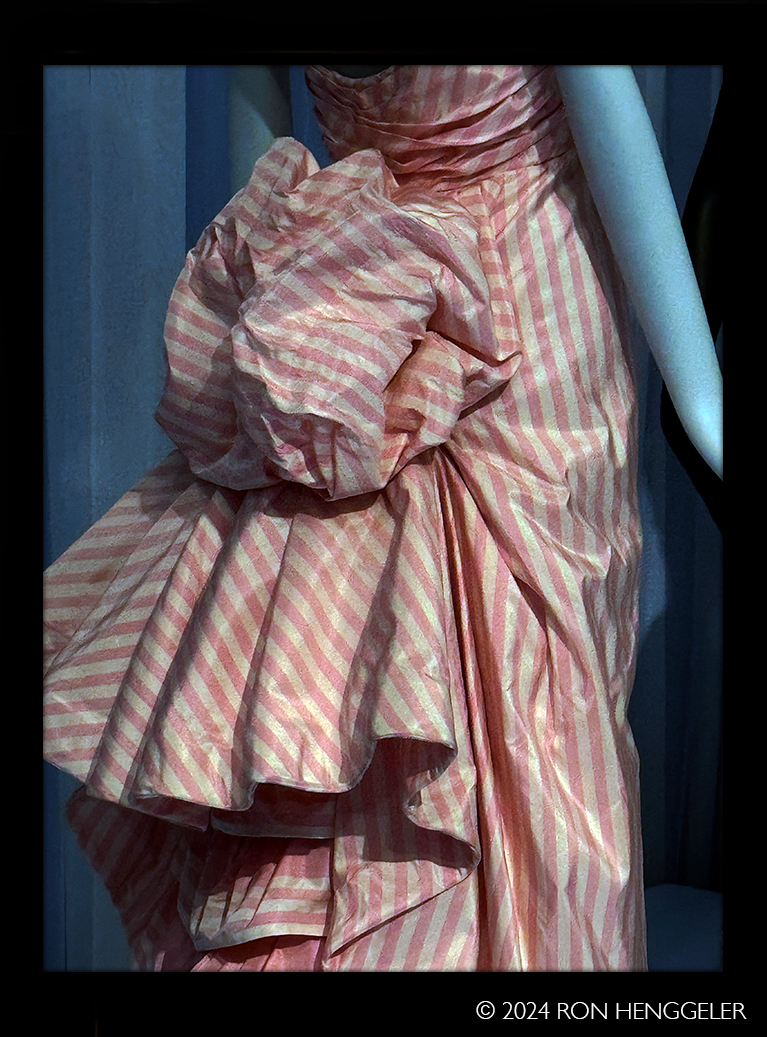| |
February 2, 2024
Photos of
Fashioning San Francisco: A Century of Style |
|
| |
|
|
| |
A Century of Style
Fashioning San Francisco: A Century of Style explores the history of fashion in San Francisco through the lens of the permanent collection of the Fine Arts Museums of San Francisco, home to one of the most significant holdings of twentieth- and twenty-first-century high fashion and haute couture in the United States. The exhibition showcases the strengths of the Museums' collection, such as French haute couture and contemporary Japanese fashion design, to examine how these holdings reflect and intersect with sociopolitical changes in the city from the early 1900s to today.
The clothes and accessories included in this presentation attest to changes in women's fashion broadly over this period but also reflect the wearers' independent style choices. Much of the Museums' collection was formed by generous gifts from local donors-among them activists, entrepreneurs, civic leaders, and philanthropists. The exhibition thus does not capture the multiplicity of San Francisco's fashion histories so much as offer focused explorations of the histories that manifest in the materiality of each object. Additional loans from communities not historically engaged by the Museums serve to broaden the narrative.
By featuring exceptional designs from this dynamic century, Fashioning San Francisco highlights how fashion is woven into our social and cultural landscape while also celebrating the distinctive qualities of individual style.
|
|
|
|
| |
Reasserting Identity
After the Great Earthquake
At the turn of the twentieth century, San Francisco was a blossoming cosmopolitan city, home to elegant restaurants and hotels, annual fairs, and cultural events. Luxurious department stores, many located on Union Square in the downtown area, sold imported gowns from New York and Europe (especially France) to a rapidly growing population of women. But in 1906 the great earthquake and fire effectively destroyed downtown's retail landscape. Within weeks, many of the city's leading retailers banded together to quickly erect a temporary shopping district.
The return of French-made models, in particular, was major news; affluent San Franciscans used fashion to reassert their individual and collective identities in the wake of disaster.
As the process of rebuilding unfolded, the city aimed to boost an image of resiliency and promote the "New San Francisco." These efforts included planning the 1915 Panama-Pacific International Exposition, a world's fair where Parisian couture gowns were prominently displayed. Department stores began their move back to the downtown area starting in 1908.
French-made clothing continued to command San Francisco's fashion landscape in the ensuing decades, with local retailers selling exclusive wares as well as American replicas and adaptations of French haute couture. |
|
| |
|
|
|
| |
Pietro Yantorny
(Italian, 1874-1936)
Shoes, 1918-1921
Suede, leather, and mother-of-pearl
Gift of the Estate of Eleanor and Charles de Limur, 2018.82.5.1a-b
Worn by Ethel Mary Crocker de Limur (American, 1891-1964) or Helen Crocker Russell (American, 1896-1966) |
|
| |
|
|
|
| |
Jeanne Lanvin
(French, 1867-1946)
Lanvin
(France, est. 1889)
Veilleur De Nuit Evening Dress, Spring/Summer 1924 Haute Couture
Silk plain weave with metal-wrapped silk and silk embroidery (chain stitch); gelatin sequins, glass bugle beads, glass rhinestones in glass settings, glass pearls, glass seed beads, and glass mirrored discs; silk with glass pearls and glass mirrored discs; metal-wrapped silk thread satin weave appliqué; and silk bobbin net with metal-wrapped thread embroidery (laid and couched stitches)
Gift of Mrs. Barbara D. Jostes, 1981.53.1
Worn by Barbara Donohoe Jostes (American, 1898-1993) |
|
| |
|
|
|
| |
|
|
| |
|
|
|
| |
Jeanne Lanvin's robe de style evening dresses, with their tubular bodices, dropped waists, and full, ankle-length skirts (often worn with side hoops), referenced eighteenth-century fashions. This version also features elements influenced by the costumes and textiles of the Manchu-led Qing dynasty (1644-1911) of China. The appliqués are reminiscent of medallions and circular embroideries worn on court robes, and the net at the hem mimics the contrast borders that adorned nonofficial, semiformal robes from the last half of the nineteenth century. |
|
| |
|
|
|
| |
|
|
| |
|
|
|
| |
Ralph Rucci
(American, b. 1957)
Ensemble: Infanta Gown & Coat,
Fall 2007 Couture
Digital printed silk gazar and digital printed silk bobbin net
Gift of Katya Sorokko Spencer in honor of Tatiana Sorokko, 2022.57a-b
Worn by Tatiana Sorokko (Russian) to the San Francisco Symphony Opening Night Gala, 2007
Structure, simplicity, and seeming weightlessness are the distinguishing characteristics of Ralph Rucci's work, and his Infanta gown perhaps best exemplifies these qualities. As implied by the design's name, Rucci was partly inspired by the voluminous gowns worn by the daughters of Spanish monarchs-famously portrayed in Diego Velázquez's paintings.
The gown's regal silhouette is achieved with a jewel neckline; small, high armholes; a raised waistline; and a triangular skirt, which lends great volume to the back. The printed design draws from the work of the seventeenth-century Dutch painter Frans van Mieris-a reference to the mutual love of art shared by the designer and his client, an art collector. |
|
| |
|
|
|
| |
|
|
| |
|
|
|
| |
Vivienne Westwood
(English, 1941-2022)
Falcon Gown,
Spring/Summer 2013 Demi-Couture
Frayed silk plain weave and plastic buttons
Gift of Christine Suppes in memory of Mary Jane Johnson,
2018.28.6.20
Worn by Christine Suppes (American) in a photoshoot for a cover story in Edelweiss Men, Autumn/Winter 2013, photographed by Frederic Aranda in Tokyo |
|
| |
|
|
|
| |
Sybil Conolly
(Irish, 1921-1998)
Evening Ensemble:
Top, Skirt, & Stole, 19983
Pleated linen plain weave and linen plain weave piping
Loan of Denise Hale
Worn by Denise Hale (Serbian) to a state dinner in honor of Her Majesty Queen Elizabeth II, de Young museum, San Francisco, March 3, 1983
Sybil Connolly's designs for women employed traditional Irish wools, lace, and linen. She is best known for her finely pleated linen evening gowns, such as this one.
To create these styles, nine yards of linen were hand-pleated to form one yard of material; in total, about seventy yards of pleated linen were required to make one gown. Linen gowns could be packed for travel without fear of wrinkling and creasing, thus suiting the needs of Connolly's most prominent clients, including former first lady of the United States Jacqueline Kennedy and the San Francisco-based philanthropist Denise Hale, a member of the International Best-Dressed Hall of Fame. |
|
| |
|
|
|
| |
Gianfranco Ferre
(Italian, 1944-2007)
Gianfranco Ferre
(Italy, est. 1974)
Evening Ensemble:
Top, Skirt, & Stole, 1991
Top: quilted silk satin weave; appliquéd silk twill weave with supplementary synthetic metal strip warp and weft patterning; and synthetic metal-wrapped thread and syn-thetic net with synthetic metal-wrapped thread machine embroidery (satin stitches, chain stitches, and basket weave stitches); Skirt: silk twill weave with supplementary synthetic metal strip warp and weft patterning; Stole: silk twill weave with supplementary synthetic metal strip warp and weft patterning; and metal-wrapped thread machine embroidery (satin stitches, chain stitches, and basket weave stitches)
Loan of Denise Hale
Worn by Denise Hale (Serbian) for her twentieth wedding anniversary, a custom design and gift from Ferré |
|
| |
|
|
|
| |
Somer and Kaufmann
(United States, active late 19th-20th century)
Shoes, ca. 1940
Cotton velvet, leather piping, and rayon twill ties |
|
| |
|
|
|
| |
Rei Kawakubo
(Japanese, b. 1942)
Comme Des Garcons
(Japan, est. 1973)
SHOES, Fall/Winter 1999 Ready-to-Wear
Leather with mercerized cotton and metal-wrapped thread machine embroidery (satin stitches); and stacked leather heel with plastic cap
Gift of Mrs. John N. Rosekrans Jr., 2012.42.27a-b
Worn by Georgette "Dodie" Rosekrans (American, 1919-2010) |
|
| |
|
|
|
| |
Designer unknown
Boots, ca. 1972
Dyed leather, metallic-coated leather, patent leather, and stacked leather heel Gift of Constance Dee, Loni Dantzler, |
|
| |
|
|
|
| |
Karl Lagerfeld
(German, active in France, 1933-2019)
Chanel
(France, est. 1910)
Shoes, Spring/Summer 2010
Silk satin weave with synthetic plain weave overlay and plastic sequin embroidery; applied leather with plastic sequins and faceted glass beads; and molded and painted plastic with rhinestones and plastic pearls
Gift of Christine Suppes in memory of Mary Jane Johnson,
2018.28.1.31a-b |
|
| |
|
|
|
| |
Beth Levine
(American, 1911-2006)
Kabuki Shoes, ca. 1965
Retailed by Saks Fifth Avenue (United States, est. 1898)
Silk satin weave and painted wood
Museum purchase, Gift of the Textile Arts Council and Textile Docents in honor of Melissa Leventon,
2002.94a-b |
|
| |
|
|
|
| |
Pietro Vantorny
(Italian, 1874-1936)
Shoes, 1918-1921
Silk and metal-wrapped thread droguets liserés; and copper metal alloy buckle with glass rhinestones Gift of Mr. Charles H. Russell, 66.44.1a-b
Worn by Ethel Mary Crocker de Limur (American, 1891-1964) or Helen Crocker Russell (American, 1896-1966) |
|
| |
|
|
|
| |
ON AURA TOUT VU
(France, est. 1998)
ENSEMBLE: GOWN AND GLOVES, Spring/Summer 2011 Haute Couture
Gown: ombré dyed silk crêpe; synthetic machine lace with faceted glass beads; faceted glass stones in white metal alloy prong settings; white metal alloy cast wings; white metal alloy chains; and faceted glass beads; Gloves: lambskin and silk velvet with cotton plain weave and quilted lambskin.
Worn by Christine Suppes (American) to the Rodin by Moonlight gala, Cantor Arts Center at Stanford University, 2011 |
|
| |
|
|
|
| |
|
|
| |
|
|
|
| |
Gianfranco Ferre
(Italian, 1944-2007)
Gianfranco Ferre
(Italy, est. 1974)
Evening Gown,
Fall/Winter 2007-2008 Ready-to-Wear
Heat-pressed silk satin weave and glass bugle beads
Gift of Yurie Pascarella, 2023.39.2
Worn by Yurie Pascarella (Japanese) to the San Francisco Symphony Opening Night Gala,
September 7, 2010
Once dubbed the "Frank Lloyd Wright of Italian Fashion" by Women's Wear Daily, Gianfranco Ferré created designs that reflected his early architectural training in Milan, distinguished by their purity of line, dramatic proportions, and consideration of functionality and movement. This silk satin weave gown was included in the final collection Ferré designed before his death in 2007. The construction of the silhouette is deceptively sophisticated; it features an inner tube dress and swags of fabric that have been gathered, draped, and stitched to achieve the weightless volume of the skirt. |
|
| |
|
|
|
| |
|
|
| |
|
|
|
| |
|
|
| |
|
|
|
| |
|
|
| |
|
|
|
| |
This is the first dress Yves Saint Laurent designed while working at the house of Christian Dior. It was famously photographed by Richard Avedon for the September 1955 issue of Harper's Bazaar as part of a fourteen-page story on Paris fashion. The simple design of this dress belies its complex construction: the body and decorative satin bow are sewn together as one piece, and the snug, narrow sleeves have zippers at their interiors that go up the full length of the arm. The Museums are home to more than
140 Dior designs, which span the house's history. Many were donated by prominent San Franciscan women, such as the civic leader Eleanor Christenson de Guigné. |
|
| |
|
|
|
| |
The Little Black Dress
A Fashion Staple
"A little black dress' of some sort or another... is considered almost indispensable in most wardrobes," declared the San Francisco Chronicle's fashion editor in 1937. Women had worn black dresses for centuries as religious attire, uniforms, sports-wear, or expressions of mourning. But the little black dress emerged as a modern-day fashion staple during World War I (1914-1918), a development spurred by the tremendous death toll, wartime fabric shortages, and economic concerns. A socially democratic garment, the little black dress was readily mass produced and widely available on the fashion market, befitting the needs and budgets of women across the social class spectrum. Today, the "little black dress" is a colloquialism that encompasses a range of styles, from short, casual daytime dresses to long, formal evening gowns. Viewed collectively, the garments in this gallery offer a lens through which to observe the evolution of dress in the twentieth and twenty-first centuries. |
|
| |
|
|
|
| |
|
|
| |
|
|
|
| |
Marie Callot Gerber
(French, 1857-1927)
Marthe Callot Betrand
(French, 1859-1920)
Regina Callot Tennyson-Chantrell
(French, 1861-?)
Josephine Callot Crimont
(French, 1866-1897)
Callot Seurs
(France, active 1895-1937)
Eesenble: Bodice and Skirt, ca. 1908, with later alterations
Silk panné velvet; silk tulle with silk appliqué; silk cording; silk needlelace; silk plain weave; and silk satin weave sash with silk and metal-wrapped silk embroidery (satin and stem stitches, couching, and French knots)
Gift of the Provident Securities Company, 54.79.1a-b
Worn by Ethel W. Sperry Crocker (American, 1861-1934) |
|
| |
|
|
|
| |
Callot Sœurs first operated as a lingerie and lacemaking business before transitioning to clothing design near the turn of the twentieth century. By the 1910s the Callot sisters were producing cylindrical-wrap dresses from pastel and metallic silks with Eastern-inspired designs that reflected European perceptions of Asian culture. San Francisco's luxury department stores, such as City of Paris, proudly retailed and promoted Callot Sœurs garments, capitalizing on the equation of imported French fashions with cosmopol-itanism. This gown belonged to Ethel Sperry Crocker, one of the most prominent philanthropists in California history. |
|
| |
|
|
|
| |
American copy of LouiseBoulanger
(French, 1878-1950)
Louise Boulanger
(France, active 1923-1939)
Evening Ensemble: Dress and Slip,
Winter 1926-1927
Dress: silk chiffon, silk machine lace, and glass rhinestones and beads; Slip: silk charmeuse, silk machine lace, and silk net Gift of Mrs. C. H. Russell, 1983.63.4a-b
Worn by Ethel Harriman Russell (American, 1897-1953) |
|
| |
|
|
|
| |
|
|
| |
|
|
|
| |
After the Ball
Formal Wear in the Big City
Philanthropy has been vital to the lived experiences of San Franciscans since the city's inception. In the mid-nineteenth century, a fast-growing population (lured by the promise of gold) and limited government infrastructure meant that many San Franciscans relied on acts of charity for survival. Formal events designed to raise funds and awareness for charitable endeavors bolstered the city's fashion sector, especially luxury department stores like the City of Paris and I. Magnin & Company, which supplied fine gowns for galas, balls, and other high-profile affairs.
The ball gown typically featured a fitted waist and lavish skirt, and was made of luxurious materials and embellishments Gowns worn by San Franciscans were of great local and national interest; the press frequently documented women's ensembles at philanthropic events or opening nights at the San Francisco Opera and San Francisco Ballet. As Life magazine proclaimed in 1952, an
"opening night gives San Francisco a chance to get the fashion jump... and the city's well-dressed women make the most of their chance." |
|
| |
|
|
|
| |
|
|
| |
|
|
|
| |
|
|
| |
|
|
|
| |
Alexander McQueen
(English, 1969-2010)
Alexander McQueen (England, est. 1992)
Evening Dress, Fall/Winter 2010 Ready-to-Wear Silk satin weave; silk open-weave plain weave; silk net; coiled wire and metal-wrapped silk thread embroidery (satin and chain stitches, French knots); painted metal sequins; painted metal beads; and glass beads with metal prongs and bezels Gift of Christine Suppes in memory of Mary Jane Johnson,
2018.28.27.10
Worn by Christine Suppes (American) in the book
Electric Fashion (Milan: Skira, 2014)
This dress was part of Alexander McQueen's final collection before his death in 2010. Unofficially and posthumously titled Angels and Demons, the collection was inspired by religious iconography, drawing from altarpieces by Byzantine, Renaissance, and Baroque artists. Hallmarks of the collection included digitally woven textiles portraying classical paintings and heavily embroidered motifs, which highlighted McQueen's career-long interest in juxtaposing handcraft with innovative techniques. This dress features intricate layers of hand embroidery, giving the effect of a carved relief sculpture; the gold scrollwork and animal motifs recall symbolism seen in religious manuscripts. |
|
| |
|
|
|
| |
|
|
| |
|
|
|
| |
|
|
| |
|
|
|
| |
|
|
| |
|
|
|
| |
Alexander McQueen
(English, 1969-2010)
Alexander McQueen (England, est. 1992)
Evening Dress, Fall/Winter 2010 Ready-to-Wear Silk satin weave; silk open-weave plain weave; silk net; coiled wire and metal-wrapped silk thread embroidery (satin and chain stitches, French knots); painted metal sequins; painted metal beads; and glass beads with metal prongs and bezels |
|
| |
|
|
|
| |
Christopher John Rogers
(American, b. 1993)
Christopher John Rogers
(United States, est. 2016)
Evening Gown, 2021
Moiré silk and silk grège
Loan of Sherri McMullen
Worn by Sherri McMullen (American) to the event Celebrating Black Art, Fashion, and Activism: Past, Present, Future, de Young museum, San Francisco, August 4, 2022 |
|
| |
|
|
|
| |
|
|
| |
|
|
|
| |
Christian Lacroix
(French, b. 1951)
Patou
(France, est. 1914)
Evening Gown
Spring/Summer 1987 Haute Couture
Silk shantung
Gift of Suzy Kellems Dominik in honor of Rita Watnick, 2023.36
Worn by Suzy Kellems Dominik (American) as co-chairperson of the San Francisco Ballet Cinderella Opening Night Gala, 2013 |
|
| |
|
|
|
| |
Oscar de la Renta
(Dominican, active in the United States, 1932-2014)
Oscar de la Renta
Gown, Fall 2005
Silk plain weave and pleated shot silk plain weave
Loan of Diane B. Wilsey
Worn by Diane B. Wilsey (American) to reopening celebrations for the de Young museum, San Francisco, 2005 |
|
| |
|
|
|
| |
|
|
| |
|
|
|
| |
|
|
| |
|
|
|
| |
|
|
| |
|
|
|
| |
|
|
| |
|
|
|
| |
JohnGalliano
(British, b. Gibraltar, 1960)
Christian Doir
(France, est. 1947)
Evening gown
Spring/Summer 1999 Haute Couture Polyamide horsehair; cotton, polyamide, and polyester blend plain weave; and metal zipper Gift of Mrs. John N. Rosekrans Jr., 2012.42.50
Worn by Georgette "Dodie" Rosekrans (American, 1919-2010) to a party celebrating Venetian Heritage at Palazzo Brandolini, Venice 1999, and to a ball at the Palace of Versailles, France, June 22, 2001 |
|
| |
|
|
|
| |
|
|
| |
|
|
|
| |
|
|
| |
|
|
|
| |
|
|
| |
|
|
|
| |
|
|
| |
|
|
|
| |
|
|
| |
|
|
|
| |
Avant-Garde
Fashion As Art
The term avant-garde is often synonymous with unusual and experimental ideas. In fashion it denotes garments or objects that redefine artistic convention; utilize new tools, materials, or techniques, and question the very nature of what constitutes clothing. San Franciscans have a long standing history of embracing radical clothing styles; local fashion mavericks especially supported boundary pushing designers in the late twentieth and twenty-first centuries.
The Museums' permanent collection preserves the legacies of the European designers Jean Paul Gaultier, John Galliano, and Alexander McQueen, who interrogated the traditional trappings of haute couture with their 1990s and 2000s collections.
It also features avant garde works by innovative artists such as the Bay Area-based Chinese American designer Kaisik Wong and Japanese designers Rei Kawakubo and Kei Ninomiya. Many of these works play with expansive and amorphous forms as a way to blur the boundary between dress and body.
|
|
| |
|
|
|
| |
Well-Suited
Upending a Sartorial Standard
The suit has been an emblem of male authority in European and North American dress for centuries. While its design has varied according to prevailing fashion, it has traditionally consisted of two to three components-a pair of trousers, a coat, and a vest-since the late eighteenth century. As women entered the workforce in larger numbers in the twentieth century, the suit also became a practical part of their wardrobes, perceived as useful for conveying power. In 1985, in a Vogue magazine symposium on fashion for working women, Dianne Feinstein, the first female mayor of San Francisco, remarked, "Women are still new to positions of power, and therefore people tend to make snap judgments about them."
Modern women's suits were often designed as so-called feminized versions of the traditional men's suit, manifested in silhouette changes, patterned textiles, and decorative accents.
The suits displayed in this gallery reflect the vital leadership roles of the Bay Area women who wore them: business owners, philanthropists, and civic leaders seeking to project confidence in a rapidly changing world. |
|
| |
|
|
|
| |
Rei Kawakubo
(Japanese, b. 1942)
Comme des Garcons
(Japan, est. 1973)
Skirt, Spring/Summer 2006 Ready-to-Wear
Plaid polyester plain weave and printed cotton jersey knit
Gift of Mrs. John N. Rosekrans Jr., 2012.42.17
Worn by Georgette "Dodie" Rosekrans (American, 1919-2010)
Prop shirt and pants |
|
| |
|
|
|
| |
|
|
| |
|
|
|
| |
|
|
| |
|
|
|
| |
|
|
| |
|
|
|
| |
|
|
| |
|
|
|
| |
|
|
| |
|
|
|
| |
|
|
| |
|
|
|
| |
|
|
| |
|
|
|
| |
Left to right:
Kei Ninomiya
(Japanese, b. 1984)
Noir Kei Ninomiya
(Japan, est. 2012)
Coat Spring 2017 Ready-to-Wear
Retailed by Modern Appealing Clothing (MAC)
(United States, est. 1980)
Nylon net and polyurethane resin faux leather with plastic rods and patinated copper alloy jump rings; white metal alloy grommets; and white metal alloy zipper
Gift of Norah and Norman Stone, 2020.18.9
Worn by Norah Stone (American, b. Canada, 1938-2019)
Prop shirt and pants |
|
| |
|
|
|
| |
|
|
| |
|
|
|
| |
|
|
| |
|
|
|
| |
|
|
| |
|
|
|
| |
|
|
| |
|
|
|
| |
Text |
|
| |
|
|
|
| |
Geoffrey Beene
(American, 1927-2004)
Suit Ensenble, Coat, and SytoleFall/Winter 1993
Coat: wool houndstooth and printed and quilted shot silk plain weave; Dress: wool houndstooth and wool braid trim; Stole: wool houndstooth; printed shot silk plain weave; plain weave bias tape with supplementary synthetic metal strips; trim of woven painted plastic beads; and synthetic tassels with painted plastic beads
Gift of Christine Suppes in memory of Mary Jane Johnson, 2017.75.8a-c
Worn by Christine Suppes (American) in the book
Electric Fashion (Milan: Skira, 2014) |
|
| |
|
|
|
| |
John Galliano
(British, b. Gibraltar, 1960)
Givenchy
(France, est. 1952)
Suit Ensemble: Jacket and Skirt,
Fall Winter 1996 Haute Couture
Printed synthetic faux fur and monkey fur
Gift of Mrs. John N. Rosekrans Jr., 2012.42.111a-b Worn by Georgette "Dodie" Rosekrans (American,
1919-2010) to Gordon Getty's birthday party, San Francisco, 1996 |
|
| |
|
|
|
| |
ALEXANDER McQUEEN (English, 1969-2010)
WITH
SIMON UNGLESS
(English, b. 1966)
ALEXANDER McQUEEN (England, est. 1992)
SUIT ENSEMBLE: JACKET AND PANTS,
Fall/Winter 1996 Ready-to-Wear
Acetate and nylon plain weave with supplementary synthetic metal wefts and supplementary acetate warps, and plastic buttons
Gift of Christine Suppes in memory of Mary Jane Johnson, 2017.75.13a-b
Worn by Christine Suppes (American) |
|
| |
|
|
|
| |
|
|
| |
|
|
|
| |
GLOBAL AESTHETIC INFLUENCES
LIFE ON THE PACIFIC RIM
By the late nineteenth century, San Francisco had emerged as a prominent port city, with a population whose ethnic diversity exceeded that of most major East Coast cities. The Museums' global costume and textiles collection, including its twentieth-and twenty-first-century high fashion and haute couture holdings, formed amid this diverse setting. Consequently, the collection reflects the centuries long practice of cultural appropriation and commodification in fashion and the arts broadly.
Cultural appropriation is typically characterized as the taking of aesthetic or material elements from one culture by a more socially powerful individual or group who is not a member of that culture without giving credit or profit. The term is often intertwined with the related concepts of cultural borrowing, exchange, and inspir-ation. Multivalent interpretations of cultural appropriation and commodification in contemporary fashion continue to evolve as legacies of subjugation are confronted and as globalization fosters a more interdependent and connected world. |
|
| |
|
|
|
| |
|
|
| |
|
|
|
| |
|
|
| |
|
|
|
| |
|
|
| |
|
|
|
| |
|
|
| |
|
|
|
| |
|
|
| |
|
|
|
| |
|
|
| |
|
|
|
| |
|
|
| |
|
|
|
| |
|
|
| |
|
|
|
| |
|
|
| |
|
|
|
| |
|
|
| |
|
|
|
| |
|
|
| |
|
|
|
| |
|
|
| |
|
|
|
| |
|
|
| |
|
|
|
| |
|
|
| |
|
|
|
| |
|
|
| |
|
|




